Building the Perfect Savannah Monitor Enclosure


Intro
Creating a suitable enclosure for a savannah monitor is foundational for their care. These reptiles are not only unique but also require specific environments to thrive. Understanding their biological needs and behavior is essential for owners. This can help ensure that your pet remains healthy and comfortable. The following sections will explore vital elements of savannah monitor care and habitat construction. We will cover their needs, maintenance, training, health, and ways to enrich their lives.
Understanding Your Pet
Pet Behavior Basics
Savannah monitors are known for their inquisitive and active nature. They tend to be curious observers, often exploring their surroundings. This behavior signifies a well-adjusted pet. It's important for the owner to spend time watching and understanding their unique body language and habits. Knowing when your savannah monitor is relaxed versus stressed can guide interactions.
Common Breed Characteristics
Savannah monitors range in size, with adults reaching up to 4 feet in length. These reptiles exhibit distinct color patterns, usually combining shades of brown and yellow. Additionally, they have strong limbs and a long tail, which helps in climbing and maneuvering through their environment. Understanding these traits allows owners to provide suitable climbing structures and hiding spots in their enclosure.
Species-Specific Needs
Savannah monitors thrive in warm environments that mimic their natural habitat in Africa. They require basking areas with higher temperatures reached by heat lamps. UVB lighting is also critical for their health, as it aids calcium absorption. Providing appropriate substrate and access to water is important for hydration and comfort. Without adequate care, these monitors may become stressed or develop health issues.
Pet Care and Maintenance
Feeding Guidelines
A balanced diet is crucial for the health of savannah monitors. They are primarily insectivores and benefit from a variety of protein sources. Crickets, roaches, and worm mixes are often recommended. It's essential to dust these with calcium and vitamin supplements to maintain bone health. Feeding should occur several times a week, with portion sizes adjusted based on age and weight.
Grooming Essentials
While savannah monitors don't require extensive grooming, regular handling can help in bonding and managing their stress levels. Bathing them occasionally helps with shedding and skin care. Always supervise this process to ensure safety and reduce anxiety.
Hygiene Practices
Maintaining cleanliness in their enclosure is vital. Regularly remove uneaten food, shed skin, and waste to prevent bacterial growth. Deep-clean the enclosure every few weeks using reptile-safe disinfectants. This helps create a healthy environment for your pet.
Training and Development
Basic Commands and Skills
Training your savannah monitor can be beneficial. Start with simple commands, offering treats as rewards. This can improve cooperation and ease handling during vet visits or cleaning.
Behavioral Training Techniques
Using positive reinforcement is an effective method for training. Gentle handling and patience can help establish trust between you and your pet. Keeping sessions short prevents overwhelm.
Addressing Common Behavior Issues
If your monitor displays aggressive behavior, it may feel threatened or stressed. Observing their environment and reducing handling times may help. It's essential to create a calm habitat by minimizing loud noises and sudden movements.
Health and Wellness
Routine Vet Check-ups
Regular veterinary visits are crucial for monitoring your savannah monitor's health. A vet experienced in reptiles can provide tailored care and ensure your pet remains in optimal condition.
Vaccination Needs
Unlike traditional pets, reptiles do not require vaccinations. However, making sure they are free from parasites is important. Regular fecal exams can provide insights into their internal health.
Recognizing Signs of Illness
Be aware of changes in behavior, appetite, or physical appearance. Signs like lethargy, weight loss, or unusual shedding may indicate underlying health issues. Early detection can lead to effective treatment and recovery.
Enrichment and Activities
Indoor vs.
Outdoor Activities
Providing varied activities is essential for mental stimulation. Indoor enclosures can include climbing furniture, while monitored outdoor time can allow natural exploration of different terrains.
Interactive Toys and Games
Using toys designed for reptiles can enhance your savannah monitor's engagement. Hiding food in enrichment devices can encourage natural foraging behavior.
Socialization Opportunities
Socializing your monitor may help with adaptability. Gradually introducing them to different environments and people can facilitate confidence in new situations. Just remember, each monitor will have unique comfort levels.
Proper understanding and care of a savannah monitor play pivotal roles in their longevity and quality of life. By following these guidelines, you can create a thriving environment for your pet.
Understanding Savannah Monitors
Understanding the savannah monitor is crucial for anyone looking to create an effective habitat for this species. By knowing their biology, behavior, and health needs, one can design an enclosure that not only fulfills their basic requirements but also fosters their overall well-being.
Biology and Natural Habitat
Savannah monitors, or Varanus exanthematicus, originate from the savannas and grasslands of Africa. An understanding of their natural environment informs several aspects of their care. In the wild, they inhabit warm savannas with access to a variety of burrows and foliage. This environment influences their physiological needs, such as temperature regulation and space for movement.
In captivity, replicating these conditions is vital for the monitor's health. Savannah monitors are long-bodied lizards, often reaching lengths of up to 4 feet, and require an enclosure that allows them to exhibit natural behaviors like climbing, hiding, and exploring. It is essential to learn their specific habitat needs therefore you can monitor and adjust their living conditions accordingly.
Behavioral Traits
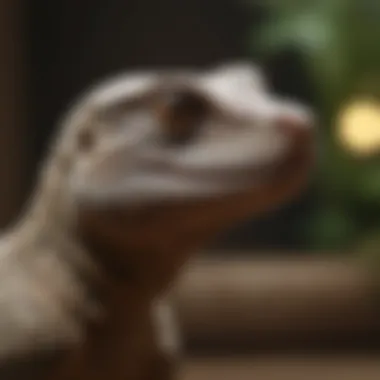
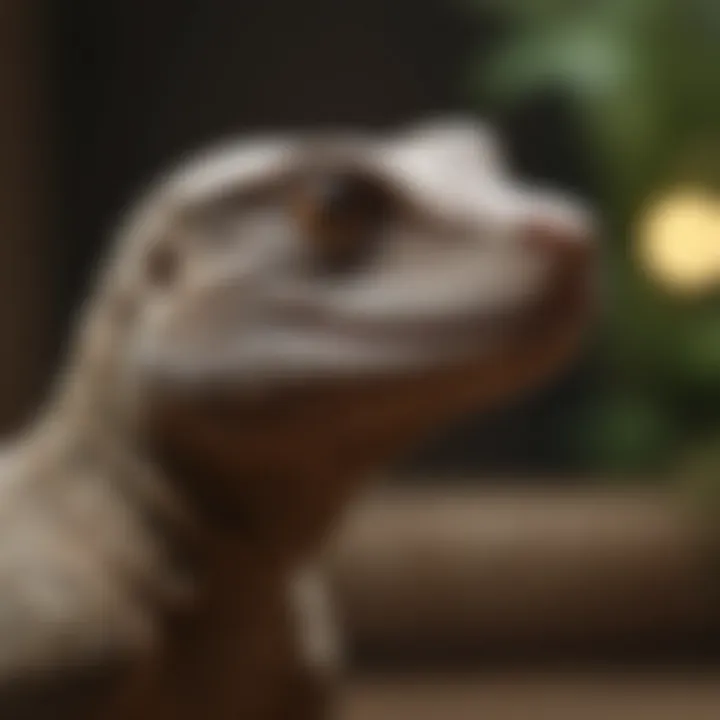
Savannah monitors exhibit a range of distinctive behaviors that are essential to understand for their suitable care. These lizards are generally solitary creatures and can display territorial behavior. Knowing this helps in planning their enclosure. Provide ample space to avoid aggressive encounters if housing multiple monitors.
Additionally, they exhibit foraging behaviors that should be encouraged. The use of enrichment, like hiding spots or items to climb on, mimics their natural search for insects and small prey. Understanding these traits is not just about creating an environment, but fostering a lifestyle that allows the monitor to thrive.
Lifespan and Health Considerations
In captivity, savannah monitors can live for 10 to 15 years, with proper care. A clear understanding of their health considerations will aid you in avoiding common pitfalls. Routine veterinary check-ups are recommended. Special attention must be paid to their diet, as nutritional deficiencies can lead to serious health issues. Utilizing a varied diet rich in insects and occasional fruits is advisable.
Furthermore, behavioral signs like lack of appetite or lethargy should not be taken lightly, as they could indicate underlying health issues. Regular monitoring of these factors will enhance your pet's lifespan and overall quality of life.
Understanding these key aspects highlights the importance of providing a functional enclosure that reflects the savannah monitor's natural habitat. This not only contributes to their health and longevity but also enriches the bond you can form with these unique reptiles.
Enclosure Size Requirements
Enclosure size is a critical aspect to consider when creating a habitat for a savannah monitor. These reptiles are naturally expansive and require a substantial amount of space to thrive. An appropriately sized enclosure not only ensures the animal's physical well-being but also promotes its mental health and encourages natural behavior. Large enclosures allow for the necessary environmental features, such as basking spots, hiding areas, and climbing structures, which are vital for their overall comfort.
A properly designed enclosure that meets size requirements will help prevent health issues related to stress and confinement. Insufficient space can lead to several problems, including weight gain and behavioral issues. Savanna monitors in cramped conditions tend to show signs of stress, which can negatively impact their health.
Minimum Size Guidelines
Establishing a minimum size guideline for a savannah monitor’s enclosure is essential. Adult savannah monitors typically require at least a 4x2x2 foot enclosure, though larger is always better. For juvenile monitors, a smaller setup may be acceptable temporarily, but it is recommended to plan for their growth. The general rule of thumb is to allow for at least double the space as they mature.
If space allows, a larger enclosure of 6x3x3 feet or more will enable the monitor to exhibit natural behaviors, reducing the likelihood of stress-related health issues. Always measure the enclosure with the understanding that more room supports enrichment and exploration.
A larger space is not just luxurious; it is a necessity for the well-being of your savannah monitor.
Space for Natural Behavior
Creating adequate space for natural behavior is vital in a savannah monitor enclosure. In the wild, these reptiles roam vast areas, hunting and exploring their environment. To replicate this necessity, the enclosure should facilitate movement and mimic aspects of their natural habitat.
Consider adding climbing structures, such as branches or shelves. Providing these allows the animal to engage in climbing behaviors. Additionally, including different substrates can encourage digging, which plays an important role in their natural behavior as well. Different areas for basking and hiding, too, can greatly enrich their experience and maintain their overall health.
A well-structured habitat fosters natural instincts and reduces signs of stress, such as lethargy or aggression. When layout and space are thoughtfully considered, a savannah monitor can flourish in a more naturalistic environment.
Materials for Your Enclosure
Selecting the right materials for a savannah monitor enclosure is crucial for several reasons. First, the materials not only determine the durability of the enclosure but also significantly impact the comfort and safety of the animal. Proper materials are essential to mimic the natural habitat of the savannah monitor and ensure they thrive in a controlled environment. Consideration of the materials helps maintain appropriate temperatures and humidity levels, which are fundamental for their health and well-being.
Selecting Appropriate Materials
When choosing materials for your enclosure, it is important to focus on usability, safety, and functionality. The common choices include glass, plywood, and melamine. Glass provides an excellent view of the animal, which enhances observation. However, it can be heavy and may require special handling. Plywood is durable and can be customized but should be sealed properly to prevent moisture damage. Melamine combines the benefits of wood with a water-resistant finish, making it an attractive option.
Each of these materials has its pros and cons:
- Glass: great visibility, heavier, higher cost.
- Plywood: sturdy, customizable, at risk of water damage if not sealed.
- Melamine: water-resistant, lighter than glass, limited designs.
Safety is paramount, as savannah monitors tend to be strong. Ensure the materials used can withstand their force if they interact with the sides of the enclosure. Adequate ventilation is also a must, which can be integrated through vents or mesh screens in glass or plywood setups.
Temperature Control Materials
Temperature control materials play a vital role in maintaining the correct thermal conditions within the enclosure. Savannah monitors require a thermal gradient to regulate their body temperature effectively. This means that there should be a warmer basking area and a cooler side for them to retreat to when needed.
To achieve this gradient, specific materials must be employed. For basking spots, materials like flat rocks or heat pads can be added. These materials absorb and retain heat, allowing the monitor to bask comfortably. Meanwhile, the cooler side can be maintained with insulating materials that prevent heat loss, such as foam board or insulation panels.
Consider the following for temperature control:
- Heating elements: ceramic heat emitters or basking bulbs for a focused heat source.
- Insulating materials: ensure the enclosure maintains temperature effectively.
- Thermometers: to monitor heat levels in different areas of the enclosure.
In summary, selecting the right materials and those suited for temperature control is essential in creating a successful savannah monitor enclosure. By focusing on safety, functionality, and temperature regulation, you create an environment that supports the health and behavior of the animal.
Designing the Enclosure
Designing a suitable enclosure for a savannah monitor is vital for its well-being. This reptile thrives in specific environmental conditions that mimic its natural habitat. A well-planned design enhances the monitor's comfort, allows for natural behaviors, and promotes overall health. In this section, we will address layout considerations and the importance of incorporating hiding and climbing spots.
Layout Considerations
When planning the layout of the enclosure, prioritize both space and structure. Savannah monitors can grow quite large. Therefore, the enclosure should provide ample room for the animals to move freely. A minimum of 8 feet long by 3 feet deep is often recommended. This space allows for various activities that align with their natural instincts.
Consider vertical space as well. Monitors are agile climbers. Including vertical dimensions will encourage climbing behaviors, which are essential for both exercise and mental stimulation. Additionally, regionally sourced materials that stimulate the savannah monitor's interest are valuable for the enclosure’s design. Placement of features within the enclosure must also be deliberate. Create zones for basking, hiding, and exploration. This configuration helps simulate a natural environment, allowing the monitor to display more natural behaviors and reducing stress levels.
Temperature and Humidity Requirements
Temperature and humidity are crucial factors in creating a proper enclosure for a savannah monitor. These reptiles are native to the warm, arid regions of Africa, and they thrive in environments that mimic their natural habitat. Adequate temperature and humidity not only affect their behavior but also play a vital role in their health and well-being.
Proper environmental conditions help prevent health issues, such as metabolic bone disease and respiratory infections, which can arise from improper care. Additionally, a carefully controlled environment allows for improved digestion and overall quality of life. Thus, understanding how to establish and maintain the right temperature and humidity is necessary for any savannah monitor owner.
Creating a Thermal Gradient
Creating a thermal gradient within the enclosure is essential. Savannah monitors need a range of temperatures to regulate their body heat effectively. A gradient consists of a hot side and a cooler side, allowing the reptile to move between areas as needed. This practice can be achieved by using heat lamps on one side of the enclosure while leaving the opposite side cooler.
The ideal basking temperature should be approximately 120°F (49°C) on the hot side, while the cooler side should maintain a temperature around 80°F (27°C). Placing a thermoregulator can help monitor these conditions constantly.
It is important to provide ample space for the savannah monitor to choose where to be comfortable. This design mimics their natural behavior of seeking warmth from the sun during the day and cooler areas at night.
Maintaining Humidity Levels
Humidity is equally important in the enclosure. Savannah monitors thrive in environments with a humidity level of about 30-50%. Too low humidity can lead to shedding problems and dehydration, while excessive humidity can contribute to respiratory issues.
Maintaining humidity involves using a variety of methods:
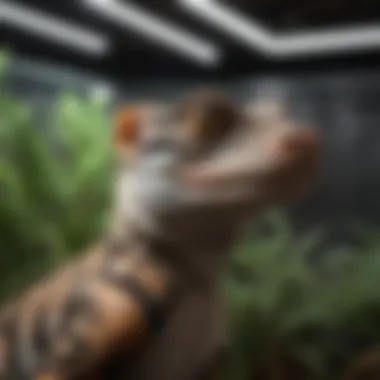
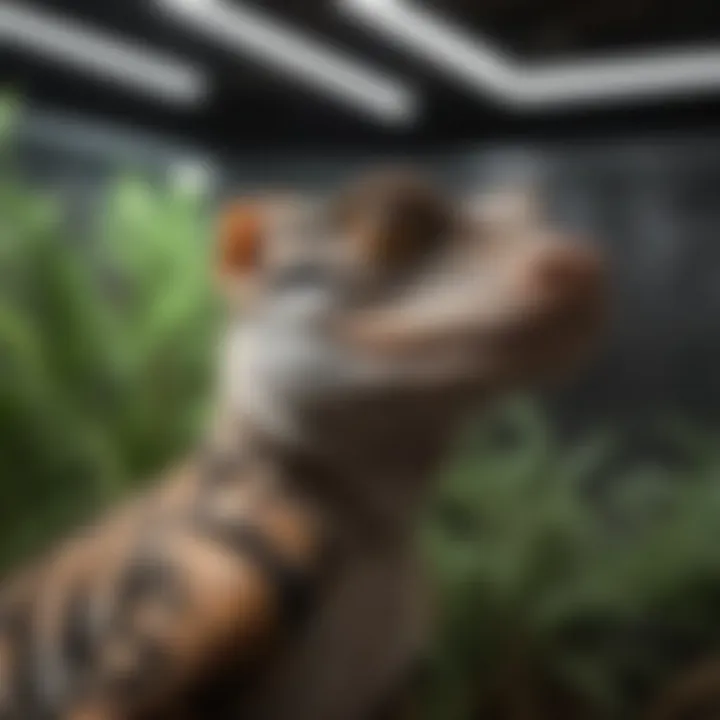
- Misting: Regularly misting the enclosure will help keep humidity levels consistent. This method is often the simplest way to enhance moisture in the habitat.
- Water bowls: Having shallow water dishes allows for drinking and soaking, which assists in achieving the needed humidity.
- Substrate choice: Selecting substrates that retain moisture, like coconut fiber, can help achieve optimal humidity levels.
Keep track of humidity levels using hygrometers. Adjust as needed to maintain the appropriate humidity, promoting a healthy and thriving environment for your savannah monitor.
Remember, a well-structured environment fosters not only the health of the reptile but also enriches their quality of life.
Lighting Needs
Proper lighting is crucial for the health and well-being of savannah monitors. These reptiles require specific lighting conditions to thrive in captivity. Good lighting supports natural behaviors and contributes to metabolic processes. Without adequate light, your savannah monitor could face serious health issues.
UVB Lighting
One of the primary needs for savannah monitors is UVB lighting. This type of light is essential because it mimics natural sunlight, which is necessary for several biological functions, such as calcium metabolism. A lack of UVB can lead to metabolic bone disease, a severe condition that affects the skeletal structure of the animal. To keep your savannah monitor healthy, invest in a high-quality UVB light that is suitable for reptiles.
Key Considerations for UVB Lighting:
- Type of Bulb: Use fluorescent tubes or compact fluorescent bulbs specifically designed for reptiles. Brands such as Zoo Med's ReptiSun and Exo Terra's Repti Glo are popular choices.
- Distance from the Animal: Place the UVB light at a distance that allows the reptile to bask comfortably. Generally, 10-12 inches is advisable, but it is wise to check the manufacturer's guidelines.
- Replacement Schedule: UVB bulbs lose their effectiveness over time. Replace them every six months to ensure that your monitor receives adequate UV radiation.
Important: Always check that your UVB lights emit the right spectrum for reptile health. Missing this can lead to quick health degradation.
Heat Sources
Alongside UVB lighting, proper heat sources are vital for maintaining the correct thermal environment. Savannah monitors, being ectothermic, depend on external heat to regulate their body temperature. In their natural habitat, they bask in the sun to reach optimal temperatures. Thus, recreating this setting in their enclosure is of utmost importance.
Effective Heat Sources:
- Basking Lamp: A strong basking bulb should be located at one end of the enclosure to create a warm area for the monitor to enjoy. Brands like Fluker's and Zoo Med offer quality basking bulbs.
- Heat Mats: Applying heat mats under part of the enclosure can provide additional warmth. This allows for belly heat, which is crucial for digestion.
- Ceramic Heat Emitters: These are another option for maintaining warmth during the night. Unlike basking bulbs, they do not emit light but provide heat without disturbing the monitor’s sleep patterns.
By ensuring that your savannah monitor has access to appropriate lighting and heat sources, you promote its overall health and well-being. Combined with proper handling and feeding, creating an environment that mimics its natural habitat is key to a thriving reptilian pet.
Substrate Choices
Choosing the right substrate is one of the most critical aspects when setting up an enclosure for a savannah monitor. The substrate not only affects the aesthetic appeal of the habitat but also plays a vital role in the health and well-being of the animal. A suitable substrate helps in maintaining the appropriate humidity levels, supports natural behaviors, and provides a safe environment for burrowing and hiding, which is essential for the monitor's comfort.
There are various materials to consider, and each has its own set of advantages and disadvantages. When selecting a substrate, pet owners must weigh factors such as ease of cleaning, ability to retain moisture, and how naturally it mimics the savannah monitor’s native habitat.
Types of Substrate
Several types of substrates can be used in a savannah monitor enclosure, including:
- Coconut Fiber: This is a popular choice due to its excellent moisture retention properties and natural look. It allows for burrowing and is biodegradable.
- Play Sand: Some owners opt for play sand, which provides a naturalistic environment. However, it can be challenging to clean and may not retain moisture well.
- Reptile Carpet: This synthetic option is easy to clean and offers a safe surface, but it is less natural and may not allow for the natural behaviors of the monitor.
- Topsoil Mix: A mixture of organic soil can be beneficial as it provides a variety of textures. It supports burrowing and can retain moisture effectively.
Each of these substrates has its own characteristics, and the choice should reflect the specific needs and behaviors of the individual savannah monitor.
Benefits of Natural Substrates
Natural substrates offer several benefits that enhance the enclosure environment for savannah monitors:
- Mimics Natural Habitat: Using natural substrates like coconut fiber or topsoil closely mimics the savannah monitor's native environment, which can reduce stress and encourage natural behaviors.
- Promotes Burrowing: Many savannah monitors enjoy burrowing. Natural substrates give them the ability to do this, which is crucial for their instinctual behavior and overall well-being.
- Moisture Regulation: Natural substrates often have better moisture retention abilities. This helps maintain appropriate humidity levels while also allowing for some drying, which is essential for a healthy environment.
- Biodegradable Options: Many natural substrates are biodegradable, making them an eco-friendly choice that can contribute to a healthier habitat.
- Aesthetic Appeal: A substrate that resembles the natural environment creates an appealing visual aspect for both the owner and the monitor.
"The appropriate substrate is more than just bedding; it is a fundamental aspect of the overall health and behavior of your savannah monitor."
Feeding and Water Considerations
Feeding and hydration are fundamental elements in providing for a savannah monitor's well-being. Proper nutrition and access to clean water not only support their physical health but also contribute to their overall happiness and lifespan. Understanding the dietary needs and ensuring the right water sources lay the groundwork for a thriving environment.
Dietary Needs
Savannah monitors have specific dietary requirements that must be met to ensure their health. They are carnivorous reptiles, primarily requiring a diet rich in protein. Common food options include insects such as crickets, mealworms, and roaches. Additionally, small rodents like mice can also be a regular part of their diet. However, you should ensure that the size of the prey is appropriate for the monitor. Feeding them prey that is too large can cause digestive issues or other health complications.
Another important aspect is the variety in their diet. Relying solely on one type of food can lead to nutritional deficiencies. It is beneficial to include a mix of insects and rodents. Supplementing their diet with vitamins and minerals like calcium is also recommended. Using a calcium powder is a common practice when feeding. Balance in nutrition will help avoid health issues, such as metabolic bone disease.
Important Points on Feeding:
- Monitor weight and eating habits regularly to catch possible health issues.
- Offer food in a way that mimics their natural hunting behavior to boost mental stimulation.
- Avoid feeding stunted or sick prey animals, as these may expose your monitor to parasites and illnesses.
Water Sources and Maintenance
Water is essential to the health of your savannah monitor. Freshwater availability is crucial, as these reptiles need hydration to function effectively. For the enclosure, a shallow dish filled with clean water should be placed. Ensure that the container is not too deep to prevent drowning. Regularly replacing the water is essential. Water should be changed daily or more often depending on how quickly it becomes dirty.
In addition to the water bowl, many monitors enjoy soaking. Providing a shallow area in their enclosure where they can comfortably submerge themselves can aid hydration and skin shedding. Be vigilant about the water quality, as stagnant water can harbor harmful bacteria.
Maintenance Tips:
- Replace the water daily to ensure it stays clean.
- Regularly clean the water dish with safe cleaning solutions to eliminate any mold or bacteria.
- Monitor the humidity levels in the enclosure. Proper humidity can enhance your monitor's health and aid in shedding.
Providing proper feeding and water conditions is vital for the health and happiness of a savannah monitor. Regular attention to these aspects ensures a thriving habitat for your reptilian pet.
Regular Maintenance of the Enclosure
Regular maintenance of the enclosure is crucial for the health and well-being of your savannah monitor. A clean and well-maintained habitat minimizes stress and prevents health issues. This section highlights key aspects that every savannah monitor owner should consider in their maintenance routine.
Cleaning Protocols
Establishing a robust cleaning protocol is paramount. This involves routine cleaning of surfaces, substrate, and decor.
- Daily Tasks: Remove uneaten food, shed skin, and waste. This reduces bacteria and other pathogens.
- Weekly Cleaning: Perform a thorough cleaning. This should include disinfecting surfaces with reptile-safe cleaning solutions. Rinse well to ensure no residues remain.
- Substrate Replacement: Depending on the substrate type used, consider replacing or refreshing it bi-weekly or monthly. For example, if using aspen shavings, they should be changed regularly to prevent mold and odors.
Important: Always allow the enclosure to dry completely before reintroducing your savannah monitor.
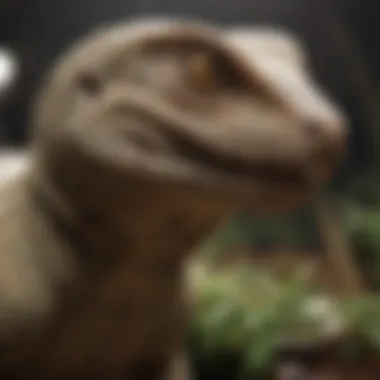

A clean environment not only promotes the health of the animal but also allows the owner to inspect for signs of illness or distress, such as changes in waste or behavior.
Monitoring Environmental Conditions
Regular checks of environmental conditions are essential to maintain a suitable habitat. Savannah monitors require specific temperature and humidity ranges to thrive.
- Temperature Control: Use a digital thermometer to monitor basking and cool areas. Basking spots should ideally be between 95°F to 105°F, while cooler areas should range from 75°F to 85°F.
- Humidity Levels: Maintaining humidity is vital. Use a hygrometer to keep levels between 30% to 50%. Adjust humidity through misting or using a water feature in the enclosure.
- Behavioral Observation: Watch your savannah monitor’s behavior. Excessive basking or hiding may indicate issues with temperature or stress levels. Regular observation helps in early detection of possible problems.
- Record Keeping: Maintain a log of temperature and humidity readings. This assists in identifying patterns in your monitor's needs and aids in making necessary adjustments.
By prioritizing cleaning and monitoring environmental conditions, savannah monitor owners can create a thriving habitat that fosters health and longevity.
Behavioral Enrichment Techniques
Behavioral enrichment techniques are essential for keeping savannah monitors healthy and mentally stimulated. These creatures, when kept in an engaging environment, display improved behavior and overall well-being. Enrichment serves to mimic their natural habitat, encouraging essential natural behaviors such as climbing, foraging, and exploring. This, in turn, helps in reducing stress and boredom, which are common issues in captive reptiles. Understanding and implementing effective enrichment strategies will significantly enhance the quality of life for your monitor.
Toys and Activities
Incorporating toys and activities can transform the enclosure of a savannah monitor into a stimulating environment. Toys encourage activity and challenge the reptile both physically and mentally. Here are some suggestions:
- Hiding Spots: Use materials like cardboard boxes or pieces of wood to create hiding spaces. This allows for secure retreats, mimicking natural shelters.
- Climbing Structures: Boughs or branches can offer climbing opportunities. Monitors are naturally agile and enjoy navigating vertical spaces.
- Interactive Objects: Objects that can be pushed or moved, such as small balls or logs, can promote interaction. These stimulate hunting instincts and curiosity.
- Foraging Items: Scatter food in various locations throughout the enclosure. This encourages the savannah monitor to search and 'hunt', engaging their minds and bodies.
These activities support physical health by promoting exercise and can contribute to essential natural instincts. Regularly rotating toys and introducing new objects can upkeep their interest.
Social Interactions
Savannah monitors are solitary by nature but can benefit from limited social interactions. It is essential to understand how best to introduce them to companionship without causing stress. Here are considerations for social enrichment:
- Owner Interaction: Handling your savannah monitor gently and regularly can help establish trust. Short sessions of interaction encourage them to become comfortable with human presence.
- Observation of Conspecifics: Some monitors may enjoy observing other monitors from a safe distance. This can foster stimulation without direct contact.
- Avoid Overcrowding: Ensuring that the enclosure is not overcrowded reduces stress. Monitors do not generally appreciate the presence of many others, as this instills competition.
In summary, social interactions should be managed delicately, considering their natural preferences. Each monitor has unique tolerance levels when it comes to social situations, and observing their behavior is key in determining the right approach.
In essence, behavioral enrichment is not just a luxury for your savannah monitor—it is a fundamental aspect of responsible pet ownership that significantly elevates their quality of life.
Understanding Legal and Ethical Considerations
Understanding the legal and ethical considerations surrounding savannah monitor ownership is essential for responsible pet keeping. It encompasses not only compliance with local laws but also the moral obligations of owners. Failing to adhere to these areas can lead to serious consequences, from health issues for the animal to legal repercussions for the owner. The importance of this section cannot be overlooked, as it lays the groundwork for a successful and ethical relationship between the owner and their reptilian companion.
Local Legislation on Ownership
Each region has specific local legislation related to the ownership of exotic pets like the savannah monitor. Laws may vary significantly, and it's vital for potential owners to research and understand their state's regulations.
Some common points to consider include:
- Species Restrictions: Some areas may have bans on certain reptile species, including monitors. It's essential to check if your locality allows savannah monitors.
- Permits and Licenses: Certain jurisdictions require owners to obtain permits to legally keep a savannah monitor. This may involve a detailed application process and possible inspections.
- Reporting Requirements: In some cases, owners must report ownership to local wildlife authorities.
To ensure compliance, visit your local government's website and check resources like en.wikipedia.org for comprehensive lists of rules and regulations applicable to exotic pet ownership. Penalties for non-compliance can include fines, confiscation of the pet, and injunctions against future ownership.
Ethical Pet Keeping
Ethical pet keeping extends beyond legal requirements; it involves creating a fulfilling and healthy environment for the savannah monitor. Owners must take their responsibilities seriously to ensure the well-being of their pet.
Key ethical considerations include:
- Commitment to Lifespan: Savannah monitors can live for up to 20 years or more. Owning one is a long-term commitment that should not be taken lightly.
- Avoidance of Wild Capture: Whenever possible, adopt from reputable breeders or rescue organizations rather than obtaining a savannah monitor through wild capture. This practice helps preserve natural populations and ecosystems.
- Providing Adequate Environment: Owners must build an enclosure that meets all necessary standards as previously discussed. This includes correct size, temperature, humidity, and enrichment features for a healthy life.
- Education and Awareness: Becoming well-informed about the needs and behaviors of savannah monitors is crucial. Regular reading and learning from reputable sources can foster deeper understanding and better care.
“Pet ownership is a responsibility that, when embraced ethically, contributes to both personal fulfillment and the welfare of the animal.”
Potential Challenges and Solutions
Creating an ideal enclosure for a savannah monitor comes with its own set of challenges. Understanding these challenges and their solutions is crucial for any pet owner. This knowledge helps to prevent potential health and behavioral problems, enhancing the overall well-being of the monitor. Here are some common issues encountered and ways to address them.
Common Health Issues
Savannah monitors can face a variety of health issues if not cared for properly. These common health problems include:
- Respiratory Infections: Often caused by poor ventilation or improper humidity levels. Owners should maintain a stable environment, ensuring proper airflow.
- Obesity: A result of overfeeding and not enough exercise. Balanced feeding schedules and space for physical activity can prevent this issue.
- Metabolic Bone Disease: Due to insufficient UVB lighting or calcium in the diet. Ensuring adequate UV exposure and a proper diet with calcium supplements is necessary.
- Parasites: Both internal and external parasites can affect health. Regular veterinary check-ups and maintaining clean environments help manage this risk.
By recognizing these health issues early and addressing them, you promote a healthier and happier life for your savannah monitor.
Behavioral Issues and Interventions
Behavioral challenges can arise in savannah monitors, often stemming from inappropriate environments or lack of stimulation. Here are some common behavioral issues:
- Aggression: Many savannah monitors may display aggressive behavior if they feel threatened. It’s essential to provide a secure and spacious habitat where they can establish territory.
- Stress: Stress can occur from improper handling or inadequate social interactions. Gradually introduce social interactions and avoid overhandling to help them adjust.
- Boredom: Lack of environmental enrichment leads to boredom, resulting in destructive behavior. Incorporating hiding spots, climbing structures, and interactive toys can entice natural behaviors and reduce boredom.
- Escape Attempts: Monitors might try to escape if they feel confined. Ensuring a well-secured enclosure with plenty of space to roam can minimize this urge.
Reasons to Choose a Savannah Monitor
Choosing to keep a savannah monitor as a pet requires careful consideration. Owners must understand their unique attributes and the responsibilities that come along with it. These reptiles are not merely exotic pets; they are complex creatures with specific needs.
Savannah monitors are known for their distinct physical characteristics. They possess a robust body and often display striking patterns. Their size can be impressive, making them a popular choice among reptile enthusiasts. However, it is essential to recognize that their care needs differ significantly from those of more conventional pets.
Unique Characteristics
Savannah monitors stand out among reptiles due to their remarkable behavior and adaptability. Here are some key features that define them:
- Intelligence: Savannah monitors are intelligent animals that can learn and be trained. This quality allows owners to foster a bond over time.
- Calm Temperament: When properly socialized, these lizards can exhibit a calm demeanor. They may not be as temperamental as other reptiles, creating a more manageable pet experience.
- Physical Attributes: Their aesthetic appeal lies in their body shape and coloration. Patterns can range from dark browns to lighter sandy tones, allowing for variety amongst individuals.
These characteristics make savannah monitors an intriguing choice, but they also come with specific requirements that must be met for optimal health.
Contributing to Biodiversity
Keeping a savannah monitor does more than fulfill a pet ownership desire. It plays a role in the broader context of biodiversity. With an increase in awareness about the importance of diverse ecosystems, reptile owners contribute to conservation efforts, particularly when acquiring their pets from responsible breeders. This practice helps to ensure that wild populations remain stable.
Here are some ways that choosing to keep savannah monitors can positively affect biodiversity:
- Awareness: Owners often become advocates for environmental conservation, spreading knowledge about the importance of reptile habitats.
- Community Involvement: Engaging in reptile clubs can foster a sense of community among owners to share best practices for care and conservation.
- Support Responsible Breeding: By opting for ethically sourced animals, owners help discourage the illegal wildlife trade that can threaten species in the wild.
Understanding the implications of ownership is vital. Pets can connect individuals with conservation principles, promoting a greater appreciation for all wildlife.







